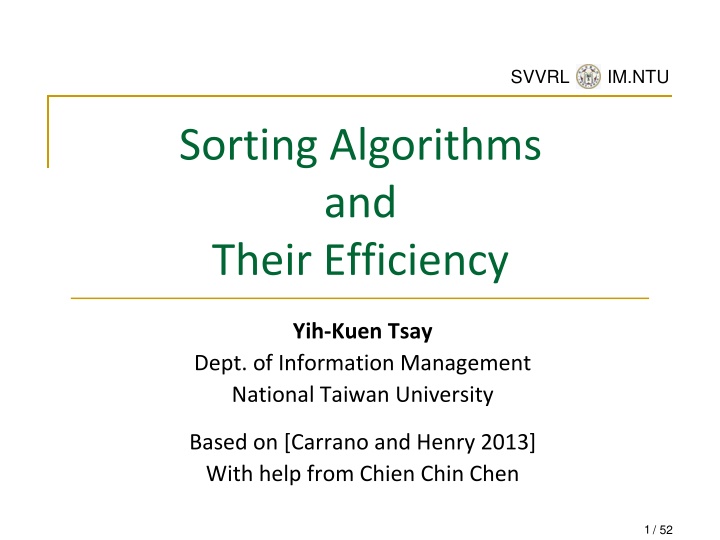
Efficiency of Sorting Algorithms at NTU
Delve into the world of sorting algorithms and their efficiency at National Taiwan University's Information Management Department, guided by Yih-Kuen Tsay and Chien Chin Chen. This comprehensive study explores the concepts of sorting, categories of algorithms, and the determination of efficiency through detailed analysis and examples.
Download Presentation

Please find below an Image/Link to download the presentation.
The content on the website is provided AS IS for your information and personal use only. It may not be sold, licensed, or shared on other websites without obtaining consent from the author. If you encounter any issues during the download, it is possible that the publisher has removed the file from their server.
You are allowed to download the files provided on this website for personal or commercial use, subject to the condition that they are used lawfully. All files are the property of their respective owners.
The content on the website is provided AS IS for your information and personal use only. It may not be sold, licensed, or shared on other websites without obtaining consent from the author.
E N D
Presentation Transcript
SVVRL @ IM.NTU Sorting Algorithms and Their Efficiency Yih-Kuen Tsay Dept. of Information Management National Taiwan University Based on [Carrano and Henry 2013] With help from Chien Chin Chen 1 / 52
SVVRL @ IM.NTU Sorting Algorithms Sorting: A process that organizes a collection of data into either ascending or descending order. The sort key The part of a data item that we consider when sorting a data collection. Categories of sorting algorithms. An internal sort: Requires that the collection of data fit entirely in the computer s main memory. An external sort: The collection of data will not fit in the computer s main memory all at once, but must reside in secondary storage. Yih-Kuen Tsay DS 2016: Sorting Algorithms and Their Efficiency 2 / 52
SVVRL @ IM.NTU Determining Efficiency Sorting in general compares, exchanges, or moves items. We should count these operations. Such operations are more expensive than ones that control loops or manipulate array indexes, particularly when the data to be sorted are complex. A sorting algorithm typically proceeds in stages/iterations. To determine its execution time, we calculate The number of iterations The number of steps/operations in each iteration Yih-Kuen Tsay DS 2016: Sorting Algorithms and Their Efficiency 3 / 52
SVVRL @ IM.NTU Selection Sort (1/8) Source: FIGURE 11-1 in [Carrano and Henry 2013]. Yih-Kuen Tsay DS 2016: Sorting Algorithms and Their Efficiency 4 / 52
SVVRL @ IM.NTU Selection Sort (2/8) /** Finds the largest item in an array. @pre The size of the array is >= 1. @post The arguments are unchanged. @param theArray The given array. @param size The number of elements in theArray. @return The index of the largest entry in the array. */ int findIndexofLargest(const ItemType theArray[], int size); /** Sorts the items in an array into ascending order. @pre None. @post The array is sorted into ascending order; the size of the array is unchanged. @param theArray The array to sort. @param n The size of theArray. */ void selectionSort(ItemType theArray[], int n) Yih-Kuen Tsay DS 2016: Sorting Algorithms and Their Efficiency 5 / 52
SVVRL @ IM.NTU Selection Sort (3/8) void selectionSort(ItemType theArray[], int n) { // last = index of the last item in the subarray of items yet // to be sorted; // largest = index of the largest item found for (int last = n - 1; last >= 1; last--) { // At this point, theArray[last+1..n-1] is sorted, and its // entries are greater than those in theArray[0..last]. // Select the largest entry in theArray[0..last] int largest = findIndexofLargest(theArray, last + 1); // Swap the largest entry, theArray[largest], with // theArray[last] std::swap(theArray[largest], theArray[last]); } // end for } // end selectionSort Yih-Kuen Tsay DS 2016: Sorting Algorithms and Their Efficiency 6 / 52
SVVRL @ IM.NTU Selection Sort (4/8) int findIndexofLargest(const ItemType theArray[], int size) { int indexSoFar = 0; // Index of largest entry found so far for (int currentIndex = 1; currentIndex < size; currentIndex++) { // At this point, theArray[indexSoFar] >= all entries in // theArray[0..currentIndex - 1] if (theArray[currentIndex] > theArray[indexSoFar]) indexSoFar = currentIndex; } // end for return indexSoFar; // Index of largest entry } // end findIndexofLargest Yih-Kuen Tsay DS 2016: Sorting Algorithms and Their Efficiency 7 / 52
SVVRL @ IM.NTU Selection Sort (5/8) Again, Sorting in general compares, exchanges, or moves items. Such operations are the more expensive ones. The for loop in the function selectionSort executes n-1 times. findIndexOfLargest and swap are called n-1 times. Yih-Kuen Tsay DS 2016: Sorting Algorithms and Their Efficiency 8 / 52
SVVRL @ IM.NTU Selection Sort (6/8) Each call to findIndexOfLargest causes its loop to execute last (or size 1) times. The loop executes a total of (n-1)+(n-2)+ + 1 = n (n-1)/2 times. Each execution of the loop performs one comparison: The calls of findIndexOfLargest require n ((n- 1)/2 comparisons. Yih-Kuen Tsay DS 2016: Sorting Algorithms and Their Efficiency 9 / 52
SVVRL @ IM.NTU Selection Sort (7/8) The n-1 calls to swap require: 3 (n-1) moves. Together, a Selection sort of n items requires: n (n-1)/2 + 3(n-1) = n2/2 + 5n/2 -3 major operations. Thus, Selection sort is O(n2). Yih-Kuen Tsay DS 2016: Sorting Algorithms and Their Efficiency 10 / 52
SVVRL @ IM.NTU Selection Sort (8/8) Does not depend on the initial arrangement of the data. Best case = worst case = average case = O(n2) Only appropriate for small n!! Yih-Kuen Tsay DS 2016: Sorting Algorithms and Their Efficiency 11 / 52
SVVRL @ IM.NTU Bubble Sort (1/4) Source: FIGURE 11-2 in [Carrano and Henry 2013]. Yih-Kuen Tsay DS 2016: Sorting Algorithms and Their Efficiency 12 / 52
SVVRL @ IM.NTU Bubble Sort (2/4) /** Sorts the items in an array into ascending order. @pre None. @post theArray is sorted into ascending order; n is unchanged. @param theArray The given array. @param n The size of theArray. */ void bubbleSort(ItemType theArray[], int n) { bool sorted = false; // False when swaps occur int pass = 1; while (!sorted && (pass < n)) { // At this point, theArray[n+1-pass..n-1] is sorted // and all of its entries are > the entries in // theArray[0..n-pass] Yih-Kuen Tsay DS 2016: Sorting Algorithms and Their Efficiency 13 / 52
SVVRL @ IM.NTU Bubble Sort (3/4) while (!sorted && (pass < n)) { // At this point, theArray[n+1-pass..n-1] is sorted // and all of its entries are > the entries in // theArray[0..n-pass] sorted = true; // Assume sorted for (int index = 0; index < n - pass; index++) { // At this point, all entries in theArray[0..index-1] // are <= theArray[index] int nextIndex = index + 1; if (theArray[index] > theArray[nextIndex]) { // Exchange entries std::swap(theArray[index], theArray[nextIndex]); sorted = false; // Signal exchange } // end if } // end for // Assertion: theArray[0..n-pass-1] < theArray[n-pass] pass++; } // end while Yih-Kuen Tsay } // end bubbleSort DS 2016: Sorting Algorithms and Their Efficiency 14 / 52
SVVRL @ IM.NTU Bubble Sort (4/4) Analysis: In the worst case, the bubble sort requires at most n-1 passes through the array. Pass 1 requires n-1 comparisons and at most n-1 exchanges. Pass 2 require n-2 comparisons and at most n-2 exchanges. ... Require a total of (n-1) + (n-2) + + 1 = n (n-1)/2 comparisons. (n-1) + (n-2) + + 1 = n (n-1)/2 exchanges. Each exchange require 3 moves. Thus, altogether there are: 2 n (n-1) = O(n2) In the best case: require only one pass. n-1 comparisons and no exchanges: O(n) Yih-Kuen Tsay DS 2016: Sorting Algorithms and Their Efficiency 15 / 52
SVVRL @ IM.NTU Insertion Sort (1/5) Source: FIGURE 11-3 in [Carrano and Henry 2013]. Yih-Kuen Tsay DS 2016: Sorting Algorithms and Their Efficiency 16 / 52
SVVRL @ IM.NTU Insertion Sort (2/5) Source: FIGURE 11-4 in [Carrano and Henry 2013]. Yih-Kuen Tsay DS 2016: Sorting Algorithms and Their Efficiency 17 / 52
SVVRL @ IM.NTU Insertion Sort (3/5) /** Sorts the items in an array into ascending order. @pre None. @post theArray is sorted into ascending order; n is unchanged. @param theArray The given array. @param n The size of theArray. */ void insertionSort(ItemType theArray[], int n) { // unsorted = first index of the unsorted region, // loc = index of insertion in the sorted region, // nextItem = next item in the unsorted region. // Initially, sorted region is theArray[0], // unsorted region is theArray[1..n-1]. // In general, sorted region is theArray[0..unsorted-1], // unsorted region theArray[unsorted..n-1] for (int unsorted = 1; unsorted < n; unsorted++) { Yih-Kuen Tsay DS 2016: Sorting Algorithms and Their Efficiency 18 / 52
SVVRL @ IM.NTU Insertion Sort (4/5) for (int unsorted = 1; unsorted < n; unsorted++) { // At this point, theArray[0..unsorted-1] is sorted. // Find the right position (loc) in theArray[0..unsorted] // for theArray[unsorted], which is the first entry in the // unsorted region; shift, if necessary, to make room ItemType nextItem = theArray[unsorted]; int loc = unsorted; while ((loc > 0) && (theArray[loc - 1] > nextItem)) { // Shift theArray[loc - 1] to the right theArray[loc] = theArray[loc - 1]; loc--; } // end while // At this point, theArray[loc] is where nextItem belongs // Insert nextItem into sorted region theArray[loc] = nextItem; } // end for } // end insertionSort Yih-Kuen Tsay DS 2016: Sorting Algorithms and Their Efficiency 19 / 52
SVVRL @ IM.NTU Insertion Sort (5/5) Analysis: In the worst case, the outer for loop executes n-1 times. This loop contains an inner while loop that executes at most unsorted times. unsorted ranges from 1 to n-1. Number of comparisons and moves: 2 [1+2+ +(n-1)] = n (n-1). The outer loop moves data items twice per iteration, or 2 (n-1) times. Together, there are n*(n-1) + 2 (n-1) = n2+n-2 major operations in the worst case, O(n2). Prohibitively inefficient for large arrays. Yih-Kuen Tsay DS 2016: Sorting Algorithms and Their Efficiency 20 / 52
SVVRL @ IM.NTU Merge Sort (1/11) Source: FIGURE 11-5 in [Carrano and Henry 2013]. Yih-Kuen Tsay DS 2016: Sorting Algorithms and Their Efficiency 21 / 52
SVVRL @ IM.NTU Merge Sort (2/11) Source: FIGURE 11-6 in [Carrano and Henry 2013]. Yih-Kuen Tsay DS 2016: Sorting Algorithms and Their Efficiency 22 / 52
SVVRL @ IM.NTU Merge Sort (3/11) A worst-case instance of the merge step Source: FIGURE 11-7 in [Carrano and Henry 2013]. Yih-Kuen Tsay DS 2016: Sorting Algorithms and Their Efficiency 23 / 52
SVVRL @ IM.NTU Merge Sort (4/11) const int MAX_SIZE = maximum-number-of-items-in-array; /** Merges two sorted array segments theArray[first..mid] and theArray[mid+1..last] into one sorted array. @pre first <= mid <= last. The subarrays theArray[first..mid] and theArray[mid+1..last] are each sorted in increasing order. @post theArray[first..last] is sorted. @param theArray The given array. @param first The index of the beginning of the first segment in theArray. @param mid The index of the end of the first segment in theArray; mid + 1 marks the beginning of the second segment. @param last The index of the last element in the second segment in theArray. @note This function merges the two subarrays into a temporary array and copies the result into the original array theArray. */ void merge(ItemType theArray[], int first, int mid, int last) Yih-Kuen Tsay DS 2016: Sorting Algorithms and Their Efficiency 24 / 52
SVVRL @ IM.NTU Merge Sort (5/11) void merge(ItemType theArray[], int first, int mid, int last) { ItemType tempArray[MAX_SIZE]; // Temporary array // Initialize the local indices to indicate the subarrays int first1 = first; // Beginning of first subarray int last1 = mid; // End of first subarray int first2 = mid + 1; // Beginning of second subarray int last2 = last; // End of second subarray // While both subarrays are not empty, copy the // smaller item into the temporary array int index = first1; // Next available location in tempArray while ((first1 <= last1) && (first2 <= last2)) // At this point, tempArray[first..index-1] is in order if (theArray[first1] <= theArray[first2]) tempArray[index++] = theArray[first1++]; else tempArray[index++] = theArray[first2++]; Yih-Kuen Tsay DS 2016: Sorting Algorithms and Their Efficiency 25 / 52
SVVRL @ IM.NTU Merge Sort (6/11) // Finish off the first subarray, if necessary while (first1 <= last1) // At this point, tempArray[first..index-1] is in order tempArray[index++] = theArray[first1++]; // Finish off the second subarray, if necessary while (first2 <= last2) // At this point, tempArray[first..index-1] is in order tempArray[index++] = theArray[first2++]; // Copy the result back into the original array for (index = first; index <= last; index++) theArray[index] = tempArray[index]; } // end merge Yih-Kuen Tsay DS 2016: Sorting Algorithms and Their Efficiency 26 / 52
SVVRL @ IM.NTU Merge Sort (7/11) /** Sorts the items in an array into ascending order. @pre theArray[first..last] is an array. @post theArray is sorted into ascending order. @param theArray The given array. @param first The index of the first entry to consider. @param last The index of the last entry to consider. */ void mergeSort(ItemType theArray[], int first, int last) { if (first < last) { // Sort each half int mid = first + (last first) / 2; // Index of midpoint // Sort left half theArray[first..mid] mergeSort(theArray, first, mid); // Sort right half theArray[mid+1..last] mergeSort(theArray, mid + 1, last); // Merge the two halves merge(theArray, first, mid, last); } // end if } // end mergeSort Yih-Kuen Tsay DS 2016: Sorting Algorithms and Their Efficiency 27 / 52
SVVRL @ IM.NTU Mergesort (8/11) Analysis (worst case): The merge step of the algorithm requires the most effort. Each merge step merges theArray[first..mid] and theArray[mid+1..last]. If the number of items in the two array segment is m: Merging the segments requires at most: m-1 comparisons. m moves from the original array to the temporary array. m moves from the temporary array back to the original array. Each merge requires 3 m-1 major operations. Yih-Kuen Tsay DS 2016: Sorting Algorithms and Their Efficiency 28 / 52
SVVRL @ IM.NTU Mergesort (9/11) Level 0 n Merge n items: 3 n-1 operations or O(n) Level 1 n/2 n/2 Merge two n/2 items: 2 (3 n/2-1) operations 3n-2 operations or O(n) Level 2 n/4 n/4 n/4 n/4 Each level requires O(n) operations . . . Level log2n (or 1 + log2n rounded down) 1 1 1 1 1 1 O(n log2n) Each level O(n) operations & O(log2n) levels Yih-Kuen Tsay DS 2016: Sorting Algorithms and Their Efficiency 29 / 52
SVVRL @ IM.NTU Mergesort (10/11) Analysis: O(n log2n). O(n log2n). Worst case: Average case: Performance is independent of the initial order of the array items. Advantage: Mergesort is an extremely fast algorithm. Disadvantage: Mergesort requires a second array as large as the original array. Yih-Kuen Tsay DS 2016: Sorting Algorithms and Their Efficiency 30 / 52
SVVRL @ IM.NTU Merge Sort (11/11) A variant of the last three loops of merging: if (first2 > last2) { // Finish off the first subarray while (first1 <= last1) // At this point, tempArray[first..index-1] is in order tempArray[index++] = theArray[first1++]; else // Need not finish off the second subarray, as the // items are already in their eventual correct places. // Remember not to copy them back from tempArray last = first2 - 1; // Copy the result back into the original array for (index = first; index <= last; index++) theArray[index] = tempArray[index]; } // end merge Yih-Kuen Tsay DS 2016: Sorting Algorithms and Their Efficiency 31 / 52
SVVRL @ IM.NTU Quick Sort (1/8) The basic idea: use the partition procedure A partition about a pivot Source: FIGURE 11-9 in [Carrano and Henry 2013]. Apply the same to S1and S2recursively. Yih-Kuen Tsay DS 2016: Sorting Algorithms and Their Efficiency 32 / 52
SVVRL @ IM.NTU Quick Sort (2/8) Draft of the algorithm in pseudocode: // Sorts theArray[first..last]. quickSort(theArray: ItemArray, first: integer, last: integer): void if (first < last) { Choose a pivot item p from theArray[first..last] Partition the items of theArray[first..last] about p // The partition is theArray[first..pivotIndex..last], // which may be depicted as S1| p | S2 quickSort(theArray, first, pivotIndex - 1) // Sort S1 quickSort(theArray, pivotIndex + 1, last) // Sort S2 } // If first >= last, there is nothing to do Yih-Kuen Tsay DS 2016: Sorting Algorithms and Their Efficiency 33 / 52
SVVRL @ IM.NTU Partition (1/4) Source: FIGURE 11-10 in [Carrano and Henry 2013]. Yih-Kuen Tsay DS 2016: Sorting Algorithms and Their Efficiency 34 / 52
SVVRL @ IM.NTU Partition (2/4) Source: FIGURE 11-10 in [Carrano and Henry 2013]. Yih-Kuen Tsay DS 2016: Sorting Algorithms and Their Efficiency 35 / 52
SVVRL @ IM.NTU Partition (3/4) // Partition with simple pivot selection partition(theArray: ItemArray, first: integer, last: integer): integer // Choose last entry as pivot // May also choose another and exchange it with last entry pivotIndex = last pivot = theArray[pivotIndex] // Determine the regions S1and S2 indexFromLeft = first indexFromRight = last 1 done = false while (not done) { // Locate first entry on left that is pivot while (theArray[indexFromLeft] < pivot) indexFromLeft = indexFromLeft + 1 // Locate first entry on right that is pivot while (theArray[indexFromRight] > pivot) indexFromRight = indexFromRight 1 Yih-Kuen Tsay DS 2016: Sorting Algorithms and Their Efficiency 36 / 52
SVVRL @ IM.NTU Partition (4/4) if (indexFromLeft < indexFromFight) { Interchange theArray[indexFromLeft] and theArray[indexFromFight] indexFromLeft = indexFromLeft + 1 indexFromRight = indexFromRight 1 } else done = true } // Place pivot in proper position between S1and S2, and // mark its new location Interchange theArray[pivotIndex] and theArray[indexFromLeft] pivotIndex = indexFromLeft return pivotIndex Yih-Kuen Tsay DS 2016: Sorting Algorithms and Their Efficiency 37 / 52
SVVRL @ IM.NTU Quick Sort (3/8) /** Sorts an array into ascending order. Uses the quick sort with median-of-three pivot selection for arrays of at least MIN_SIZE entries, and uses the insertion sort for other arrays. @pre theArray[first..last] is an array. @post theArray[first..last] is sorted. @param theArray The given array. @param first The first element to consider in theArray. @param last The last element to consider in theArray. */ void quickSort(ItemType theArray[], int first, int last) Yih-Kuen Tsay DS 2016: Sorting Algorithms and Their Efficiency 38 / 52
SVVRL @ IM.NTU Quick Sort (4/8) void quickSort(ItemType theArray[], int first, int last) { if (last - first + 1 < MIN_SIZE) insertionSort(theArray, first, last); else { // Create the partition: S1 | Pivot | S2 int pivotIndex = partition(theArray, first, last); // Sort subarrays S1 and S2 quickSort(theArray, first, pivotIndex - 1); quickSort(theArray, pivotIndex + 1, last); } // end if } // end quickSort Yih-Kuen Tsay DS 2016: Sorting Algorithms and Their Efficiency 39 / 52
SVVRL @ IM.NTU Quicksort (5/8) The major effort in the quicksort function occurs during the partition step. Worst case: The worst case behavior for quicksort occurs when the partition produces one sub-problem with n-1 elements and one with 0 elements. And unbalanced partition arises in each recursive call. When the array is already sorted and the smallest item is chosen as the pivot. Because S2decreases in size by one at each recursive call to quicksort. The maximum number of recursive calls to quicksort will occur. Yih-Kuen Tsay DS 2016: Sorting Algorithms and Their Efficiency 40 / 52
SVVRL @ IM.NTU Quicksort (6/8) For an array of n items: In the worst case, the 1st partition requires n-1 comparisons to partition the n items in the array. On the next recursive call to quicksort: Partition is passed n-1 items. So it will require n-2 comparisons to partition them. Therefore, quicksort requires: (n-1) + (n-2) + + 1 = n (n-1)/2 comparisons. O(n2). Yih-Kuen Tsay DS 2016: Sorting Algorithms and Their Efficiency 41 / 52
SVVRL @ IM.NTU Quicksort (7/8) When S1and S2contain about the same number of items, there would be about log2n levels of recursive calls to quickSort, like in mergeSort. The average case of Quick sort is O(n log2n). Quicksort is usually extremely fast in practice. Even if the worst case occurs, quicksort s performance is acceptable for moderately large arrays. Yih-Kuen Tsay DS 2016: Sorting Algorithms and Their Efficiency 42 / 52
SVVRL @ IM.NTU Quick Sort (8/8) Source: FIGURE 11-13 in [Carrano and Henry 2013]. Yih-Kuen Tsay DS 2016: Sorting Algorithms and Their Efficiency 43 / 52
SVVRL @ IM.NTU Improved Partition (1/4) Medium-of-three pivot selection: Sort the three in order and put away the pivot Source: FIGURES 11-11 and 11-12 in [Carrano and Henry 2013]. Yih-Kuen Tsay DS 2016: Sorting Algorithms and Their Efficiency 44 / 52
SVVRL @ IM.NTU Improved Partition (2/4) sortFirstMiddleLast(theArray: ItemArray, first: integer, mid: integer, last: integer): void if (theArray[first] > theArray[mid] Interchange theArray[first] and theArray[mid] if (theArray[mid] > theArray[last] Interchange theArray[mid] and theArray[last] if (theArray[first] < theArray[mid] Interchange theArray[first] and theArray[mid] Yih-Kuen Tsay DS 2016: Sorting Algorithms and Their Efficiency 45 / 52
SVVRL @ IM.NTU Improved Partition (3/4) // Partition with medium-of-three pivot selection. partition(theArray: ItemArray, first: integer, last: integer): integer // Choose pivot and reposition it mid = first + (last first) / 2 sortFirstMiddleLast(theArray, first, mid, last) Interchange theArray[mid] and theArray[last 1] pivotIndex = last - 1 pivot = theArray[pivotIndex] // Determine the regions S1and S2 indexFromLeft = first + 1 indexFromRight = last 2 done = false while (not done) { // Locate first entry on left that is pivot while (thearray[indexFromLeft] < pivot) indexFromLeft = indexFromLeft + 1 // Locate first entry on right that is pivot while (thearray[indexFromRight] > pivot) Yih-Kuen Tsay indexFromRight = indexFromRight 1 DS 2016: Sorting Algorithms and Their Efficiency 46 / 52
SVVRL @ IM.NTU Improved Partition (4/4) if (indexFromLeft < indexFromFight) { Interchange theArray[indexFromLeft] and theArray[indexFromFight] indexFromLeft = indexFromLeft + 1 indexFromRight = indexFromRight 1 } else done = true } // Place pivot in proper position between S1and S2, and // mark its new location Interchange theArray[pivotIndex] and theArray[indexFromLeft] pivotINdex = indexFromLeft return pivotIndex Yih-Kuen Tsay DS 2016: Sorting Algorithms and Their Efficiency 47 / 52
SVVRL @ IM.NTU Radix Sort (1/4) A radix sort of eight four-digit integers Source: FIGURE 11-14 in [Carrano and Henry 2013]. Yih-Kuen Tsay DS 2016: Sorting Algorithms and Their Efficiency 48 / 52
SVVRL @ IM.NTU Radix Sort (2/4) The algorithm in pseudocode: // Sorts n d-digit integers in the array theArray radixSort(theArray: ItemArray, n: integer, d: integer): void for (j = d downto 1) { Initialize 10 groups to empty Initialize a counter for each group to 0 for (i = 0 through n 1) { k = j-th digit of the Array[i] Place theArray[i] at the end of group k Increase k-th counter by 1 } Replace the items in theArray with all the items in group 0, followed by all the items in group 1, and so on. } Yih-Kuen Tsay DS 2016: Sorting Algorithms and Their Efficiency 49 / 52
SVVRL @ IM.NTU Radix Sort (3/4) To sort n d-digit numbers, Radix sort requires: n moves each time it forms groups. n moves to combine them into one group. Totally, 2 n d moves. Thus, the Radix sort is O(n), if we treat d as a constant. Yih-Kuen Tsay DS 2016: Sorting Algorithms and Their Efficiency 50 / 52






















